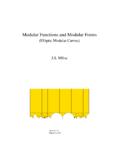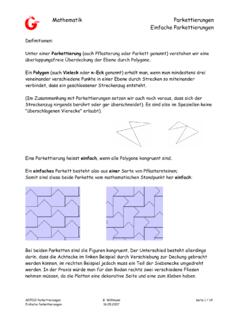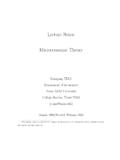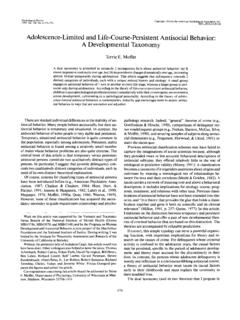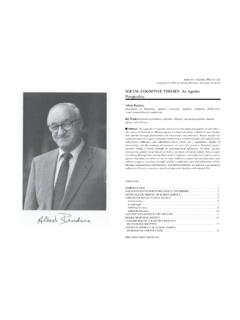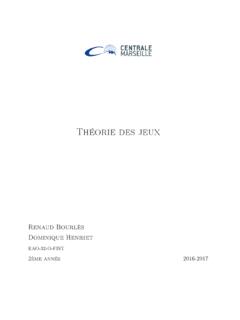Transcription of Fields and Galois Theory - James Milne
1 Fields and Galois MilneQ Q Cx Q p 7 Qh 3ih 2ih i=h 3ih i=h 2iSplitting field ofX7 ; Q Q QNHG=NSplitting field ofX5 2021 These notes give a concise exposition of the Theory of Fields , including the Galois theoryof finite and infinite extensions and the Theory of transcendental extensions. The first sixchapters form a standard course, and the final three chapters are more information@misc{milneFT,author={ Milne , James S.},title={ Fields and Galois Theory ( )},year={2021},note={Available at },pages={142}}Please send comments and corrections to me at jmilne at (August 21, 1996). First version on the (May 27, 1998). Fixed many minor errors; 57 (April 3, 2002). Revised notes; minor additions to text; added 82 exercises withsolutions, an examination, and an index; 100 (February 19, 2005). Revised notes; added proofs for Infinite Galois Extensions;expanded Transcendental Extensions; 107 (January 22, 2008). Minor corrections and improvements; added proofs for Kummertheory; 111 (February 11, 2008).
2 Replaced Maple with PARI; 111 (April 15, 2012). Minor fixes; added sections on etale algebras; 124 (March 18, 2014). Added chapter on the Galois Theory of etale algebras (Chapter 8);other improvements; numbering has changed; 138 (April 2020). Minor fixes and additions; numbering little changed; 138 (June 2021). First version available (with its source code) under a Creative is published under a Creative Commons International licence (CC BY-NC-SA ).Licence information: 1996 2021 ..6 References..61 Basic Definitions and Results7 Rings ..7 Fields ..8 The characteristic of a field ..8 Review of polynomial rings ..10 Factoring polynomials ..11 Extensions ..14 The subring generated by a subset ..15 The subfield generated by a subset ..15 Construction of some extensions ..16 Stem Fields ..17 Algebraic and transcendental elements ..18 Transcendental numbers ..19 Constructions with straight-edge and compass.
3 21 Algebraically closed Fields ..24 Exercises ..252 Splitting Fields ; Multiple Roots27 Homomorphisms from simple extensions..27 Splitting Fields ..28 Multiple roots ..30 Exercises ..333 The Fundamental Theorem of Galois Theory35 Groups of automorphisms of Fields ..35 Separable, normal, and Galois extensions ..37 The fundamental theorem of Galois Theory ..39 Examples ..42 Constructible numbers revisited ..43 The Galois group of a polynomial ..44 Solvability of equations ..45 Exercises ..464 Computing Galois Groups47 When isGf An? ..473 When doesGfact transitively on the roots? ..48 Polynomials of degree at most three ..49 Quartic polynomials ..49 Examples of polynomials withSpas Galois group overQ..51 Finite Fields ..52 Computing Galois groups overQ..54 Exercises ..585 Applications of Galois Theory59 Primitive element theorem..59 Fundamental Theorem of Algebra ..61 Cyclotomic extensions.
4 62 Dedekind s theorem on the independence of characters ..65 The normal basis theorem ..66 Hilbert s Theorem 90 ..69 Cyclic extensions ..71 Kummer Theory ..72 Proof of Galois s solvability theorem ..74 Symmetric polynomials ..75 The general polynomial of degreen..78 Norms and traces ..79 Exercises ..836 Algebraic Closures85 Zorn s lemma ..85 First proof of the existence of algebraic closures ..86 Second proof of the existence of algebraic closures ..86 Third proof of the existence of algebraic closures ..87(Non)uniqueness of algebraic closures ..88 Separable closures ..887 Infinite Galois Extensions91 Topological groups ..91 The Krull topology on the Galois group ..92 The fundamental theorem of infinite Galois Theory ..95 Galois groups as inverse limits ..98 Nonopen subgroups of finite index ..99 Exercises .. 1008 The Galois Theory of etale algebras103 Review of commutative algebra .. 103 Etale algebras over a field.
5 104 Classification of etale algebras over a field .. 106 Comparison with the Theory of covering spaces.. 1109 Transcendental Extensions111 Algebraic independence .. 111 Transcendence bases .. 112L uroth s theorem .. 115 Separating transcendence bases .. 1184 Transcendental Galois Theory .. 119 Exercises .. 119A Review Exercises121B Two-hour Examination127C Solutions to the use the standard (Bourbaki) notation:NDf0;1;2;:::g;ZDring of integers,RDfield of real numbers,CDfield of complex numbers,FpDZ=pZDfield withpelements,pa prime an equivalence relation, denotes the equivalence class containing . The cardinalityof a setSis denoted byjSj(sojSjis the number of elements inSwhenSis finite). LetIandAbe sets. A family of elements ofAindexed byI, denoted , is a functioni7!aiWI!A. Throughout the notes,pis a prime number:pD2;3;5;7;11;:::.X Y Xis a subset ofY(not necessarily proper).XdefDY Xis defined to beY, or equalsYby Y Xis isomorphic 'Y XandYare canonically isomorphic (or there is a given or unique isomorphism).
6 PREREQUISITESG roup Theory (for example, GT), basic linear algebra, and some elementary Theory of , N., 1964, Lectures in Abstract Algebra, Volume III, van , the following of my notes (available at ).GTGroup Theory , , Number Theory , , Primer of Commutative Algebra, , nnnn on open source computer algebra system that you can run in your browser. It is freelyavailable thank the following for providing corrections and comments for earlier versions of the notes:Mike Albert, Terezakis Alexios, Carlos Alberto Ajila Loayza, Lior Bary-Soroker, MarenBaumann, Leendert Bleijenga, Jin Ce, Tommaso Centeleghe, Sergio Chouhy, DemetresChristofides, Antoine Chambert-Loir, Dustin Clausen, Keith Conrad, Daniel Duparc, HardyFalk, Ralf Goertz, Le Minh Ha, Matin Hajian, Jens Hansen, Albrecht Hess, Tim Holzschuh,Philip Horowitz, Ivan Ip, Trevor Jarvis, Henry Kim, Martin Klazar, Jasper Loy Jiabao,Weiyi Liu, Dmitry Lyubshin, Geir Arne Magnussen, John McKay, Sarah Manski, GeorgesE.
7 Melki, Courtney Mewton, C Nebula, Shuichi Otsuka, Dmitri Panov, Artem Pelenitsyn,Alain Pichereau, David G. Radcliffe, Roberto La Scala, Chad Schoen, Ren e Schoof, Prem LSharma, Dror Speiser, Sam Spiro, Bhupendra Nath Tiwari, Mathieu Vienney, Martin Ward(and class), Yervand Yeghiazarian, Xiande Yang, Wei Xu, and Definitions and ResultsRingsAringis a setRwith two binary operationsCand such that(a).R;C/is a commutative group;(b) is associative, and there exists1an element1 Rsuch thata 1 RDaD1R afor alla2RI(c) the distributive law holds: for alla;b;c2R,.aCb/ cDa cCb ca .bCc/Da bCa usually omit and write1for1 Rwhen this causes no confusion. If1RD0, a ringRis a subsetSthat contains1 Rand is closed under addition, passageto the negative, and multiplication. It inherits the structure of a ring from that of rings WR!R0is a map such that .aCb/D .a/C .b/; .ab/D .a/ .b/; .1R/D1R0for alla;b2R. A ringRis said to becommutativeif multiplication is commutative:abDbafor alla;b2R:A commutative ring is said to be anintegral domainif1R 0and the cancellation lawholds for multiplication,abDac,a 0, impliesbDc:AnidealIin a commutative ringRis a subgroup ;C/that is closed under multiplicationby elements ofR,r2R,a2I, impliesra2I:The ideal generated by elementsa1;:::;anis denoted ;:::;an/.
8 For example,.a/isthe principal assume that the reader has some familiarity with the elementary Theory of example, inZ(more generally, any Euclidean domain) an idealIis generated by any smallest nonzero element ofI, and unique factorization into powers of prime elementsholds. We write ;b/for the greatest common divisor ofaandb, , ;0/Da:1We require that rings have a1, which entails that we require homomorphisms to preserve BASICDEFINITIONS Afieldis a setFwith two composition lawsCand such that(a).F;C/is a commutative group;(b).F ; /, whereF DFXf0g, is a commutative group;(c) the distributive law , a field is a nonzero commutative ring such that every nonzero element has an particular, it is an integral domain. A field contains at least two distinct elements, smallest, and one of the most important, Fields isF2DZ=2 ZDf0; a fieldFis a subring that is closed under passage to the inverse. Itinherits the structure of a field from that nonzero commutative ringRis a field if and only if it has no ideals thatRis a field, and letIbe a nonzero ideal inR.
9 Ifais a nonzero elementofI, then1Da 1a2I, and soIDR. Conversely, suppose thatRis a commutative ringwith no proper nonzero ideals. Ifa 0, , and so there exists abinRsuch The following are Fields :Q,R,C,FpDZ=pZ(pprime):Ahomomorphi sm of fieldsis simply a homomorphism of rings. Such a homomorphismis always injective, because its kernel is a proper ideal (it doesn t contain1), which musttherefore be a field. AnF-algebra(oralgebra overF) is a ringRcontainingFas a subring(so the inclusion map is a homomorphism). Ahomomorphism ofF-algebras WR!R0isa homomorphism of rings such that .c/Dcfor characteristic of a fieldOne checks easily that the mapZ!F; n7!n 1 FdefD1FC1FC of1F/;is a homomorphism of rings. For example,.1FC C1F .. C1F ..n/D1FC C1F ..mCnbecause of the associativity of addition. Therefore its kernel is an ideal : The kernel of the map , so thatn 1FD0(inF)H)nD0(inZ).Nonzero integers map to invertible elements ofFundern7!
10 N 1 FWZ!F, and so this mapextends to a homomorphismmn7!.m 1F/.n 1F/ 1WQ,!F:The characteristic of a field9In this case,Fcontains a copy ofQ, and we say that it hascharacteristic :The kernel of the map is .0/, so thatn 1FD0for somen 0. The smallestpositive suchnwill be a primep(otherwise there will be two nonzero elements inFwhoseproduct is zero), andpgenerates the kernel. Thus, the mapn7!n 1 FWZ!Fdefines anisomorphism fromZ=pZonto the subringfm 1 Fjm2 ZgofF. In this case,Fcontains a copy ofFp, and we say that it field isomorphic to one of the fieldsF2;F3;F5;:::;Qis called aprime field. Everyfield contains exactly one prime field (as a subfield). generally, a commutative ringRis said to havecharacteristicp( ) ifit contains a prime field (as a subring) of characteristicp( ).2 Then the primefield is unique and, by definition, contains1R. Thus, ifRhas characteristicp 0, then1RC C1RD0(pterms).LetRbe a nonzero commutative ring. IfRhas characteristicp 0, thenpadefDaC Ca.









